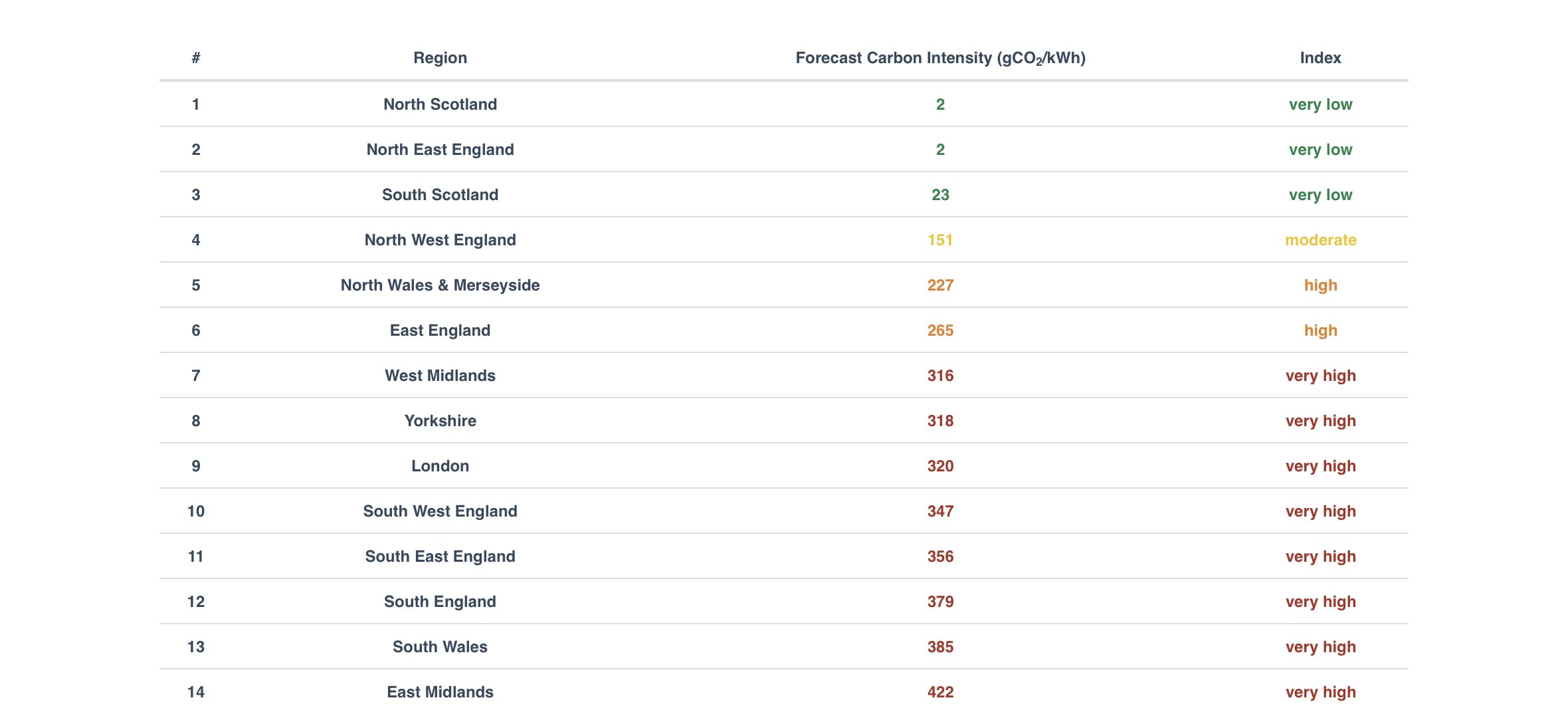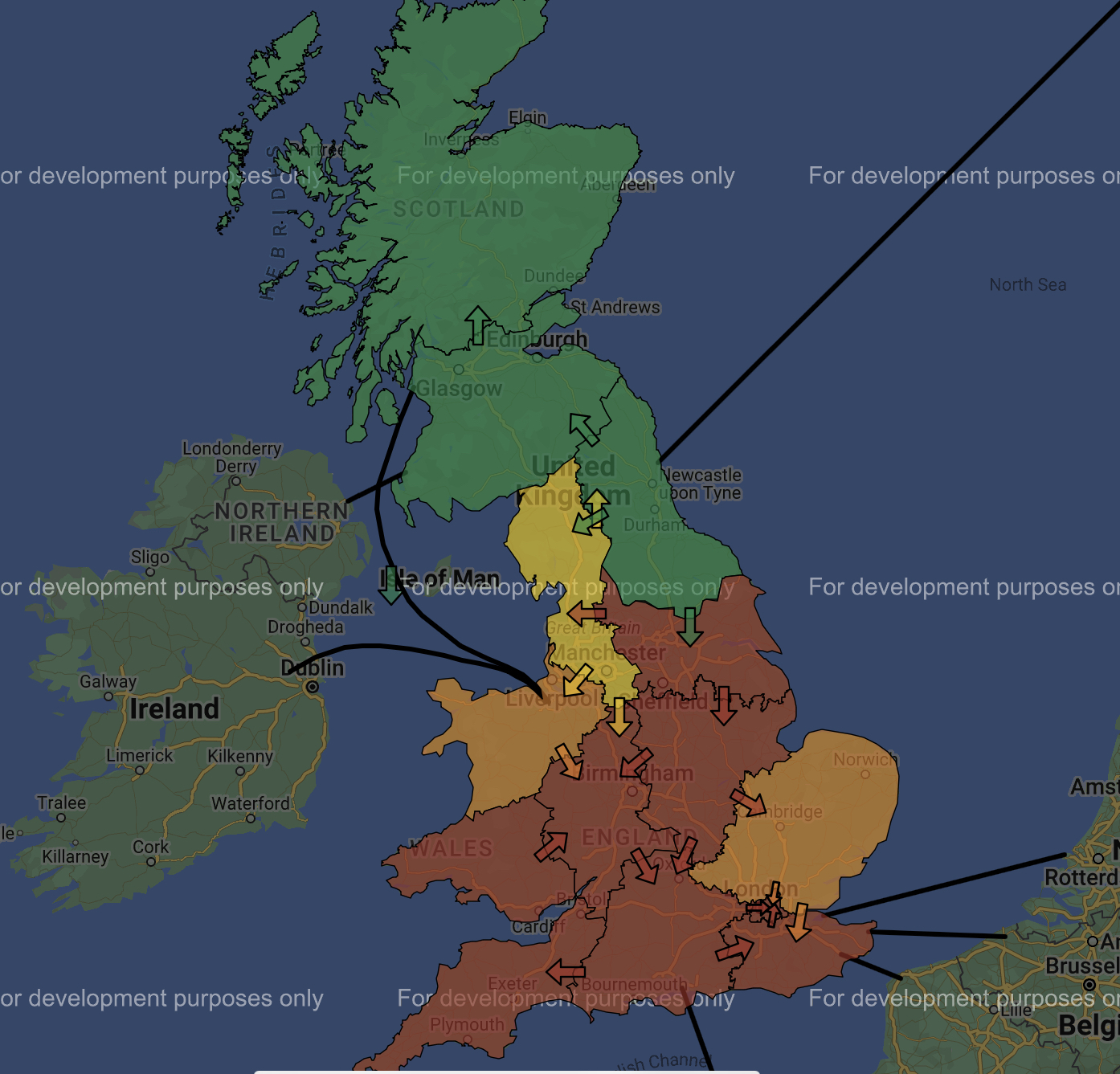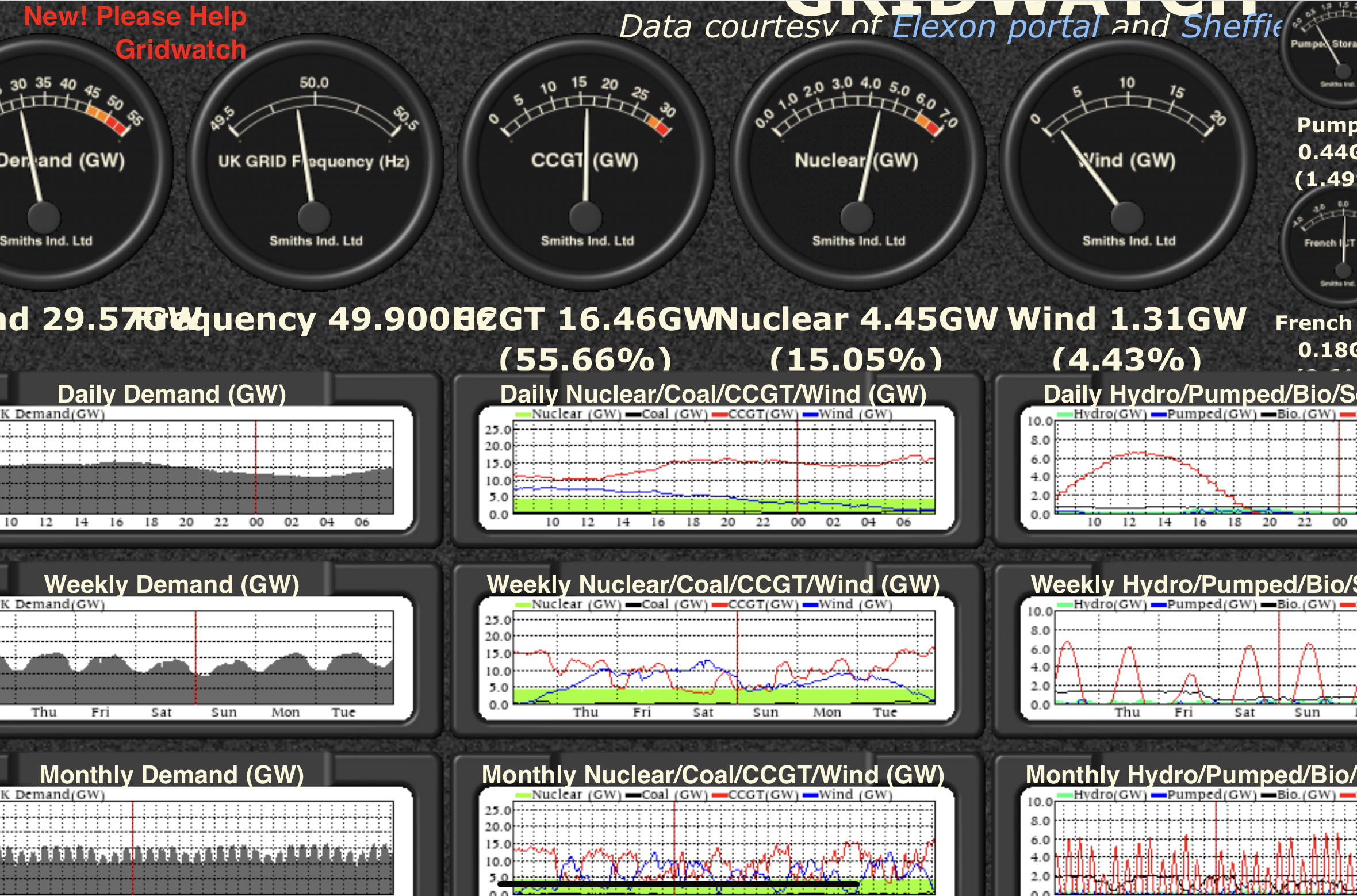We’d like to remind Forumites to please avoid political debate on the Forum.
This is to keep it a safe and useful space for MoneySaving discussions. Threads that are – or become – political in nature may be removed in line with the Forum’s rules. Thank you for your understanding.
📨 Have you signed up to the Forum's new Email Digest yet? Get a selection of trending threads sent straight to your inbox daily, weekly or monthly!
EV Discussion thread
Comments
-
Today’s prices https://electricinsights.co.uk/#/dashboard?start=2023-08-22&&_k=11u8zlmichaels said:
Which probably still gives a cheaper average unit cost of generation than in the daytime when we might have same wind, nuclear etc but 17.5 of gas, hence lower prices in the market in the night period that are passed on to the consumer to some extent via the TOU tariffs.JKenH said:
That may be true some days but in the early hours of this morning we had 10 GW of wind, 4.3GW of nuclear,7.5GW gas and 0.5GW coal.ABrass said:In reality the nighttime cheap rates are cheap because we have too much nuclear and renewable power overnight most of the time so if we don't boost use then power gets wasted.
Northern Lincolnshire. 7.8 kWp system, (4.2 kw west facing panels , 3.6 kw east facing), Solis inverters, Solar IBoost water heater, Mitsubishi SRK35ZS-S and SRK20ZS-S Wall Mounted Inverter Heat Pumps, ex Nissan Leaf owner)0 -
My TOU tariff is fixed for a two year period so is probably not set based on the experience of a single day 68% of the way through the fix?I think....0
-
Apologies, I misunderstood. I thought you were referring to the average over the nighttime compared to the daytime yesterday rather than over the year.michaels said:My TOU tariff is fixed for a two year period so is probably not set based on the experience of a single day 68% of the way through the fix?Northern Lincolnshire. 7.8 kWp system, (4.2 kw west facing panels , 3.6 kw east facing), Solis inverters, Solar IBoost water heater, Mitsubishi SRK35ZS-S and SRK20ZS-S Wall Mounted Inverter Heat Pumps, ex Nissan Leaf owner)0 -
I’ve done a bit more research and the relationship between Agile prices and wholesale prices is explained on the energy stats uk website as follows
Calculate the Agile price yourself from wholesale costs
Pull a 30 minute slot from day ahead pricing via Epex:
- Say the price listed for a 10am slot is £123/MWh, you’d first need to divide that by 1000 to convert it to pennies and kWh.
- £123 / 1000 = £0.123 (12.3p)
- Times that by 2.2 = 27p (this is the standard Agile multiplier)
- Because it’s not 4pm – 7pm there is no more to add (otherwise add 12p at peak times)
- Then add VAT at 5%, so 27p x 1.05 = 28.4p
https://energy-stats.uk/wholesale-energy-pricing/
I then had a look in a bit more detail at the Agile pricing, this time for East Midlands, my home region and this is the last years data
There were several days in January when the import price was negative (indicating supply >demand) so I zoomed in on the January data (below) https://dashboards.energy-stats.uk/d/5cZqqmf4z/user-dashboard?orgId=1&from=1672531200000&to=1675209599000
https://dashboards.energy-stats.uk/d/5cZqqmf4z/user-dashboard?orgId=1&from=1672531200000&to=1675209599000
There were therefore a few mornings in the East Midlands had negative pricing than nothing until April and then a gap to July. The figures will vary region by region.Edit: here are the April and July graphs with hourly detail for 15/16 July

 Northern Lincolnshire. 7.8 kWp system, (4.2 kw west facing panels , 3.6 kw east facing), Solis inverters, Solar IBoost water heater, Mitsubishi SRK35ZS-S and SRK20ZS-S Wall Mounted Inverter Heat Pumps, ex Nissan Leaf owner)0
Northern Lincolnshire. 7.8 kWp system, (4.2 kw west facing panels , 3.6 kw east facing), Solis inverters, Solar IBoost water heater, Mitsubishi SRK35ZS-S and SRK20ZS-S Wall Mounted Inverter Heat Pumps, ex Nissan Leaf owner)0 -
The amount of gas being used for generation overnight isn't necessarily a true reflection of total demand & is often dictated by geography. High demand in the SE will require the use of CCGT generators while at the same time wind generation is being curtailed in Scotland. Plugging an EV in to charge overnight in Scotland or near the East Coast has a high probability of being a zero emissions charge. It's not just a case of 'when' - the 'where' element will also be relevant until National Grid sort out the infrastructure to distribute renewables more widely.4kWp (black/black) - Sofar Inverter - SSE(141°) - 30° pitch - North LincsInstalled June 2013 - PVGIS = 3400Sofar ME3000SP Inverter & 5 x Pylontech US2000B Plus & 3 x US2000C Batteries - 19.2kWh1
-
And the corollary to that, of course is that in some areas in the UK the carbon intensity of the grid will be higher than average. Here’s today’s forecast. In the East Midlands, of course, we have the Ratcliffe on Soar coal fired station running today.1961Nick said:The amount of gas being used for generation overnight isn't necessarily a true reflection of total demand & is often dictated by geography. High demand in the SE will require the use of CCGT generators while at the same time wind generation is being curtailed in Scotland. Plugging an EV in to charge overnight in Scotland or near the East Coast has a high probability of being a zero emissions charge. It's not just a case of 'when' - the 'where' element will also be relevant until National Grid sort out the infrastructure to distribute renewables more widely.Oh dear, I hope no one starts comparing EV emissions with ICE cars, again.
Edit: wrong link. Correct one here. https://carbonintensity.org.uk/
Edit 2: interesting looking at the arrows some of the higher intensity regions are sending power to the lower intensity areas, e.g. south Scotland to North Scotland - why would that be? Edit 3: Perhaps this explains why Scotland is importing energy. Maybe Mick Lynch has taken over wind generation. As demand ramps up wind goes on strike.
Edit 3: Perhaps this explains why Scotland is importing energy. Maybe Mick Lynch has taken over wind generation. As demand ramps up wind goes on strike. Northern Lincolnshire. 7.8 kWp system, (4.2 kw west facing panels , 3.6 kw east facing), Solis inverters, Solar IBoost water heater, Mitsubishi SRK35ZS-S and SRK20ZS-S Wall Mounted Inverter Heat Pumps, ex Nissan Leaf owner)0
Northern Lincolnshire. 7.8 kWp system, (4.2 kw west facing panels , 3.6 kw east facing), Solis inverters, Solar IBoost water heater, Mitsubishi SRK35ZS-S and SRK20ZS-S Wall Mounted Inverter Heat Pumps, ex Nissan Leaf owner)0 -
Negative prices happen only when the inflexible supply (wind, nuclear, coal, some CCGT) are producing too much, the flexible supplies are all turned off and Pumped Hydro, Interconnectors and normal use are all saturated.JKenH said:
That may be true some days but in the early hours of this morning we had 10 GW of wind, 4.3GW of nuclear,7.5GW gas and 0.5GW coal.ABrass said:In reality the nighttime cheap rates are cheap because we have too much nuclear and renewable power overnight most of the time so if we don't boost use then power gets wasted.
Edit: I was interested to know how frequently we were wasting power and the only way I could think of accessing this information easily was to use negative Agile prices as a proxy.I looked at this year to date and chose the London region, simply because I presumed this to be the most populous. My source was agileprices.co.uk.
Each day is divided into 48 half hour blocks.
The results are as follows (number of half hour blocks and % of time.
January 24 and 0%
Feb 0 and 0%
March 1 and 0% (at 0500)
April 6 and 0% (5 between 0000 and 0330 on one day and 1 at 2330
May 0 and 0%
June 0 and 0%
July 59 and 4% (of which 9 blocks were between 0000 and 0700 over 2 days and 50 outside these hours)
August 0 and 0%
From this it appears that only on 4 days this year have Agile prices been negative at any time between 0000 and 0700 and for a total of 7.5 hours or approximately one hour each month on average.
https://agileprices.co.uk/?region=C&fromdate=20230731
As we boost the amount of renewables in the grid we will have more power at night from those inflexibile supplies. We will continue to use gas and interconnectors to balance things but we need to get more users onto night time use tarrifs.
As for the 'kettle at half time' effect of having a single 1am tarrif for EV users that's easily managed by using the smarter end of the market to flex their start times or to stagger the cheap period for some users. It's all solvable with current technology and systems. We don't need to fix that problem yet because it doesn't need fixing yet, we just need to know we can.8kW (4kW WNW, 4kW SSE) 6kW inverter. 6.5kWh battery.1 -
ABrass said:As for the 'kettle at half time' effect of having a single 1am tarrif for EV users that's easily managed by using the smarter end of the market to flex their start times or to stagger the cheap period for some users. It's all solvable with current technology and systems. We don't need to fix that problem yet because it doesn't need fixing yet, we just need to know we can.We already do. The old E7 tariffs used to switch in at different times based on region. Currently with EV charging we have TOU tariffs but also tariffs like Intelligent Octopus which is essentially one as well. You state you want a certain charge by a certain time and IO determines when it is supplied to your car overnight. The 6 hours of cheap electricty you are promised may even be extended at their discretion.As you say, it really isn't an insurmountable problem. From going on the EV boards there are even people who, where possible, charge when there is plenty of cheap electricity even when they themselves are on fixed prices. Not a significant impact in terms of numbers, no doubt, but diversity is what helps us here.The assertion that recent EVs are using electricity that is less green due to calling on gas is a bit of a reductio ad absurdum argument. It may be true in certain circumstances but doesn't actually lead to any useful conclusion.
1 -
Heat pumps & EVs are creating a demand that the generators have to respond to. Initially the response can be to turn up the CCGTs but eventually capacity & transmission will have to be addressed. As long as solar, wind & nuclear eventually satisfy the extra demand then the grid gets greener.
The slow take up of heat pumps in the UK is probably a good thing at the moment as the grid just isn't ready for mass conversion to electricity for heating. EVs have the option to charge overnight so create less of a problem. When the next generation of domestic heat pumps with an 80C flow temperature capability reach the market the grid infrastructure needs to be ready... but it probably won't be as we're likely to see them within 5 years.
The 2 major bottlenecks for the expansion of wind generation/distribution need to be addressed by the Government - CFDs need to reflect recent cost price inflation & planning needs to be speeded up.4kWp (black/black) - Sofar Inverter - SSE(141°) - 30° pitch - North LincsInstalled June 2013 - PVGIS = 3400Sofar ME3000SP Inverter & 5 x Pylontech US2000B Plus & 3 x US2000C Batteries - 19.2kWh0 -
But can we rely on solar, wind and nuclear to plug the gap when the gas fired stations shut down? There just isn’t enough nuclear in the pipeline and wind is too intermittent. On the morning of 16 August, wind and solar were non existent and gas was producing over 60% of our generation. Between midnight an 2pm wind never got above 1GW and at one point was as low as 0.28GW - that’s equivalent to 1% of installed capacity. Solar can at best on average contribute only half of the day but in winter is not much help. In December Solar produced less than 1% of our generation so we can forget it in terms of energy security, just as we can interconnects. When the chips are down in a European energy crisis we won’t be getting any help from across the Channel or the North Sea.1961Nick said:Heat pumps & EVs are creating a demand that the generators have to respond to. Initially the response can be to turn up the CCGTs but eventually capacity & transmission will have to be addressed. As long as solar, wind & nuclear eventually satisfy the extra demand then the grid gets greener.
The slow take up of heat pumps in the UK is probably a good thing at the moment as the grid just isn't ready for mass conversion to electricity for heating. EVs have the option to charge overnight so create less of a problem. When the next generation of domestic heat pumps with an 80C flow temperature capability reach the market the grid infrastructure needs to be ready... but it probably won't be as we're likely to see them within 5 years.
The 2 major bottlenecks for the expansion of wind generation/distribution need to be addressed by the Government - CFDs need to reflect recent cost price inflation & planning needs to be speeded up.On a good day, wind can produce as much, if not more than gas but no one should plan around good days. On 16th August, looking at the day as a whole, wind could only produce a twentieth of demand and a tenth of what gas contributed that day. Too many people are promoting wind as a replacement for gas based on hype from the renewables sector without looking at the reality. The good news is constantly being pushed and the bad news swept under the carpet. Everyone talks about averages and conveniently forgets the peaks and troughs. Very little investment is being made in long term storage. There is lots of news coming out about storage projects but not at the TWh scale we need. We could well end up keeping most of our existing gas capacity on standby at enormous cost.
We used 0.35 TWh of gas on 16th August and wind produced 0.3TWh. With 5 times our current wind capacity (say 135GW) we would have produced 0.15 TWh - that’s still a 0.2TWh shortfall. Then what do we do with 135GW on a windy day. If we produce 100GW for 24 hours that’s 2.4 TWh. Our demand may have doubled but we are still going to be curtailing half that wind as we won’t have anywhere to store it. It is not unusual to get several windy days in a row. Does anyone factor in the cost of storage and curtailment when assessing the cost of wind? I understand the climate change argument for building out lots more wind but you are sensible enough to realise that the cost will be enormous compared to our present set up and that will land with the consumer.
Out of interest how much wind capacity would you say we will be needed to replace gas? And how much storage?Northern Lincolnshire. 7.8 kWp system, (4.2 kw west facing panels , 3.6 kw east facing), Solis inverters, Solar IBoost water heater, Mitsubishi SRK35ZS-S and SRK20ZS-S Wall Mounted Inverter Heat Pumps, ex Nissan Leaf owner)2
Confirm your email address to Create Threads and Reply

Categories
- All Categories
- 352.9K Banking & Borrowing
- 253.9K Reduce Debt & Boost Income
- 454.7K Spending & Discounts
- 245.9K Work, Benefits & Business
- 602K Mortgages, Homes & Bills
- 177.8K Life & Family
- 259.8K Travel & Transport
- 1.5M Hobbies & Leisure
- 16K Discuss & Feedback
- 37.7K Read-Only Boards




